Research on Tea Tree Growth Monitoring Model Using Soil Information
Abstract
:1. Introduction
2. Research Methodology
2.1. Study Area and Subject
2.2. Data Acquisition
2.2.1. Soil Information Data
2.2.2. Tea Growth Data
2.3. Experimental Platform
3. Model Construction Experiments and Analysis
3.1. Data Processing
3.2. Evaluation Indicators
3.3. Model Construction of Tea Growth
3.3.1. Model Prediction of Temperature and Tea Growth
3.3.2. Model Prediction of Soil Moisture Content and Tea Growth
3.3.3. Model Prediction of Soil Electrical Conductivity and Tea Growth
3.3.4. Model Prediction of Tea Growth with Multiparameter Fusion
3.3.5. Model Prediction Performance Validation
3.3.6. Summary
4. LSTM Networks Model Optimized by BES
4.1. LSTM
4.2. BES
4.3. Algorithm Optimization
- (1)
- Process the data and split it into training set and test set.
- (2)
- Initializing the parameters of the BES and the LSTM networks.
- (3)
- Obtain the best parameters using the BES to set up the LSTM network.
- (4)
- The RMSE of the model is used as the fitness, and the fitness of each population in the BES is calculated, and the minimum value is taken as the optimal solution result.
- (5)
- Iterate the operation and update the parameters of the LSTM using the BES algorithm.
- (6)
- Repeat (4)–(5) until the end of the condition.
- (7)
- Prediction of the LSTM network using the final optimized parameters.
4.4. Evaluation Indicators
4.5. Experimental Analysis
4.6. Summary
5. Conclusions
- (1)
- The tea tree growth monitoring model needs to be strengthened. As tea tree growth monitoring is more influenced by other factors in the environment, it has yet to be further studied in depth. The relationship between tea tree growth monitoring and the influence of meteorological parameters, atmosphere, etc., should be effectively studied and integrated into the model to achieve better results.
- (2)
- More effective network model applications are expected. Since the impact of each parameter in the soil information is also mutual, more complex networks need to be used to build models that can better predict and improve the accuracy of prediction.
- (3)
- Data samples need to be increased. The remote sensing data used in this study are only of one year, and only 72 remote sensing images can be extracted to extract NDVI, this making the data applied to the experiment obviously less. More NDVI data should be obtained, and the period of the experiment should be extended, so that the accuracy and applicability of the prediction model can be improved.
Author Contributions
Funding
Institutional Review Board Statement
Informed Consent Statement
Data Availability Statement
Conflicts of Interest
References
- Zhang, H.; Chen, H.; Zhou, G.; Ge, H. Crop growth dynamics monitoring technology: A review. In Proceedings of the 27th Annual Meeting of the Chinese Meteorological Society Conference on Modern Agricultural Meteorological Disaster Prevention and Mitigation and Food Security, Beijing, China, 21 October 2010. [Google Scholar]
- Zhu, H.F. Development of RS-Based Crop Growth Monitoring and Diagnosis System. Master’s Thesis, Nanjing Agricultural University, Nanjing, China, 2008. [Google Scholar]
- Liu, Q. Quantitative Remote Sensing Models, Applications and Uncertainty Research; Science Press: Beijing, China, 2010. [Google Scholar]
- Jackson, R.D.; Idso, S.B.; Reginato, R.J.; Pinter, P.J., Jr. Canopy temperature as a crop water stress indicator. Water Resour. Res. 1981, 17, 1133–1138. [Google Scholar] [CrossRef]
- Kogan, F. Global drought and flood-watch from NOAA polar-orbitting satellites. Adv. Space Res. 1998, 21, 477–480. [Google Scholar] [CrossRef]
- Ghebrezgabher, M.G.; Yang, T.; Yang, X.; Sereke, T.E. Assessment of NDVI variations in responses to climate change in the Horn of Africa. Egypt. J. Remote Sens. Space Sci. 2020, 23, 249–261. [Google Scholar] [CrossRef]
- Ren, R.; He, Z.; Liang, H.; Xia, C.; Zhang, L.; Yang, M. Spatiotemporal variation of NDVI and its response to changes in temperature and precitation in Guizhou procince. Res. Soil Water Conserv. 2021, 28, 118–129. [Google Scholar] [CrossRef]
- Bai, X.; Zhang, L.; He, C.; Zhu, Y. Estimating Regional Soil Moisture Distribution Based on NDVI and Land Surface Temperature Time Series Data in the Upstream of the Heihe River Watershed, Northwest China. Remote Sens. 2020, 12, 2414. [Google Scholar] [CrossRef]
- Zhe, M.; Zhang, X. Time-lag effects of NDVI responses to climate change in the Yamzhog Yumco Basin, South Tibet. Ecol. Indic. 2021, 124, 107431. [Google Scholar] [CrossRef]
- Al-Shehhi, M.R.; Saffarini, R.; Farhat, A.; Al-Meqbali, N.K.; Ghedira, H. Evaluating the effect of soil moisture, surface temperature, and humidity variations on MODIS-derived NDVI values. In Proceedings of the 2011 IEEE International Geoscience and Remote Sensing Symposium, Vancouver, BC, Canada, 24–29 July 2011; pp. 3160–3163. [Google Scholar] [CrossRef]
- Chen, T.; de Jeu, R.; Liu, Y.; van der Werf, G.; Dolman, A. Using satellite-based soil moisture to quantify the water driven variability in NDVI: A case study over mainland Australia. Remote Sens. Environ. 2014, 140, 330–338. [Google Scholar] [CrossRef]
- Mattar, C.; Wigneron, J.-P.; Sobrino, J.A.; Novello, N.; Calvet, J.C.; Albergel, C.; Richaume, P.; Mialon, A.; Guyon, D.; Jimenez-Munoz, J.C.; et al. A Combined Optical–Microwave Method to Retrieve Soil Moisture Over Vegetated Area. IEEE Trans. Geosci. Remote Sens. 2012, 50, 1404–1413. [Google Scholar] [CrossRef]
- Zhao, X.; Tan, K.; Zhao, S.; Fang, J. Changing climate affects vegetation growth in the arid region of the northwestern China. J. Arid Environ. 2011, 75, 946–952. [Google Scholar] [CrossRef]
- Krishnan, P.; Maity, P.P.; Kundu, M. Sensitivity analysis of cultivar parameters to simulate wheat crop growth and yield under moisture and temperature stress conditions. Heliyon 2021, 7, e07602. [Google Scholar] [CrossRef] [PubMed]
- Zhang, Y. The Status, Problems, and Solution of Crop Growth Monitoring by Remote Sensing. Master’s Thesis, Lanzhou University, Lanzhou, China, 2020. [Google Scholar]
- Zhang, Y. Research on NDVI Prediction of Haixi Prefecture Using Graph Neural Network and Time Series Decomposition Algorithm. Master’s Thesis, Lanzhou University, Lanzhou, China, 2021. [Google Scholar]
- Stadler, A.; Rudolph, S.; Kupisch, M.; Langensiepen, M.; van der Kruk, J.; Ewert, F. Quantifying the effects of soil variability on crop growth using apparent soil electrical conductivity measurements. Eur. J. Agron. 2015, 64, 8–20. [Google Scholar] [CrossRef]
- Silva, S.D.A.; dos Santos, R.O.; de Queiroz, D.M.; Lima, J.S.D.S.; Pajehú, L.F.; Medauar, C.C. Apparent soil electrical conductivity in the delineation of management zones for cocoa cultivation. Inf. Process. Agric. 2021, 2, 004. [Google Scholar] [CrossRef]
- Peralta, N.R.; Costa, J.L.; Balzarini, M.; Angelini, H. Delineation of management zones with measurements of soil apparent electrical conductivity in the southeastern pampas. Can. J. Soil Sci. 2013, 93, 205–218. [Google Scholar] [CrossRef]
- Peralta, N.R.; Costa, J.L. Delineation of management zones with soil apparent electrical conductivity to improve nutrient management. Comput. Electron. Agric. 2013, 99, 218–226. [Google Scholar] [CrossRef] [Green Version]
- Rousseau, D.; Dee, H.M.; Pridmore, T. Imaging Methods for Phenotyping of Plant Traits. In Phenomics in Crop Plants: Trends, Options and Limitations; Kumar, J., Pratap, A., Kumar, S., Eds.; Springer: New Delhi, India, 2015. [Google Scholar] [CrossRef]
- Tsaftaris, S.A.; Minervini, M.; Scharr, H. Machine Learning for Plant Phenotyping Needs Image Processing. Trends Plant Sci. 2016, 21, 989–991. [Google Scholar] [CrossRef] [Green Version]
- Angermueller, C.; Pärnamaa, T.; Parts, L.; Stegle, O. Deep learning for computational biology. Mol. Syst. Biol. 2016, 12, 878. [Google Scholar] [CrossRef] [PubMed]
- Li, R.; Tao, H.; Zhang, Z.; Wang, P.; Liao, S. Study on Summer Maize Group Growth Monitoring Based in Image Processing Technique. J. Maize Sci. 2010, 18, 128–132. [Google Scholar] [CrossRef]
- Ma, Y. Research on the Remote and Dynamic Monitoring Technology for Winter Wheat and Summer Corn Growth Condition Based on Digital Image. Master’s Thesis, Huazhong Agriculture University, Hangzhou, China, 2010. [Google Scholar]
- Yan, Y.; Hang, H.; Liu, G.; Wu, H.; Wu, H.; Dai, X.; Yu, P. Study of corn field monitoring and application system based on deep-learing recognition mode. Meteorol. Sci. Technol. 2019, 47, 571–580. [Google Scholar] [CrossRef]
- Liang, S.; Shi, P.; Xing, Q. A Comparison Between the Algorithms for Removing Cloud Pixel from MODIS NDVI Time Series Data. Remote Sens. Land Resour. 2011, 23, 33–36. [Google Scholar]
- Xu, X.; Lin, Z.; Xue, F. Correlation analysis between meteorological factors and ratio of vegetation cover. Acta Ecol. Sin. 2003, 23, 221–230. [Google Scholar]
- Zheqin Technology. MEC20 Soil Moisture/Conductivity/Temperature Sensor User’s Manual; V1.2.; Dalian Zheqin Technology Co.: Dalian, China, 2018. [Google Scholar]
- Gers, F.A.; Schmidhuber, J.; Cummins, F. Learning to Forget: Continual Prediction with LSTM. Neural Comput. 2000, 12, 2451–2471. [Google Scholar] [CrossRef] [PubMed]
- Alsattar, H.A.; Zaidan, A.A.; Zaidan, B.B. Novel meta-heuristic bald eagle search optimisation algorithm. Artif. Intell. Rev. 2019, 53, 2237–2264. [Google Scholar] [CrossRef]
- Jia, H.; Jiang, Z.; Li, Y. Simultaneous optimization feature selection based on improved condor search algorithm. Control. Decis. 2020. [Google Scholar] [CrossRef]
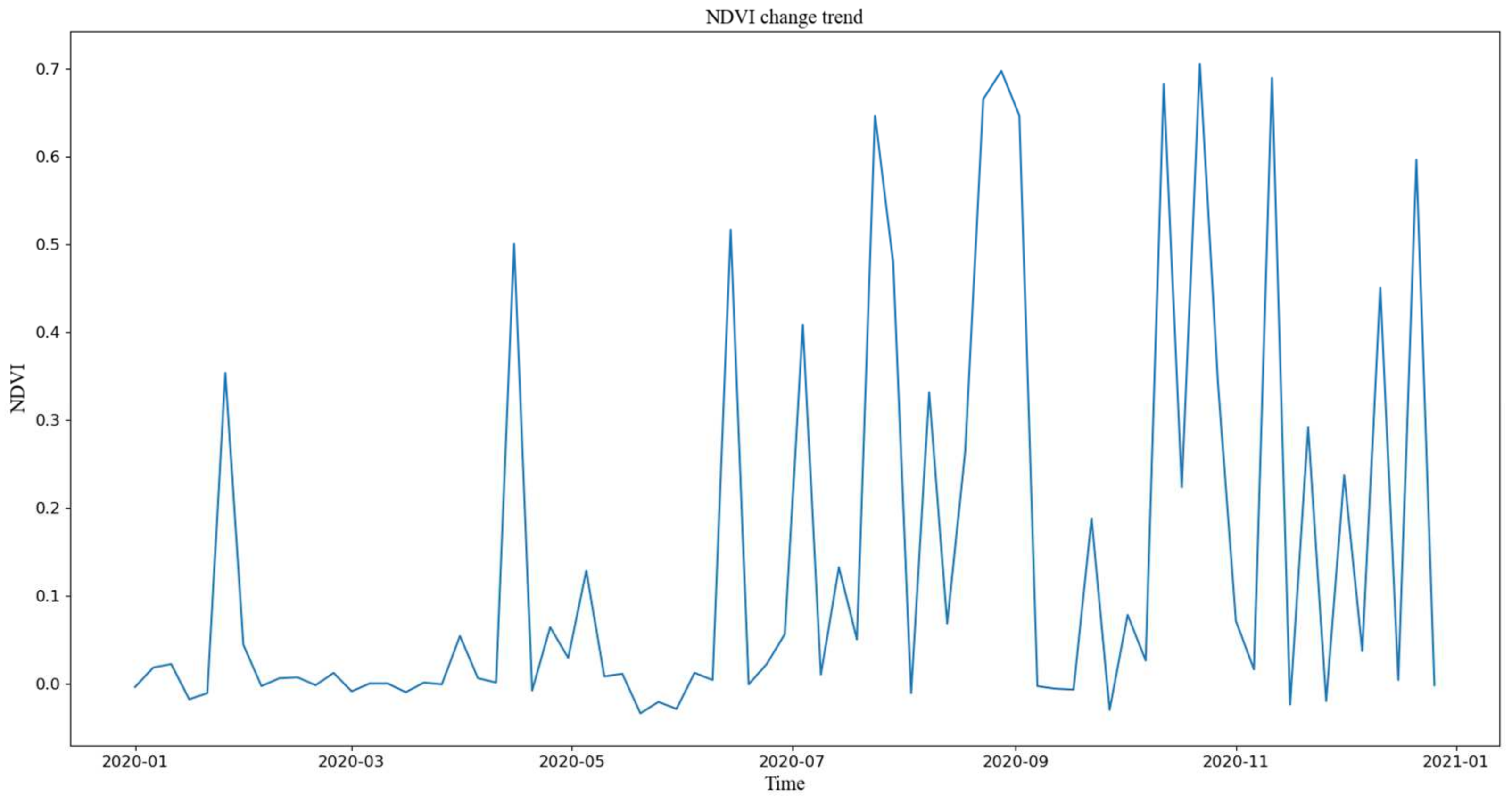
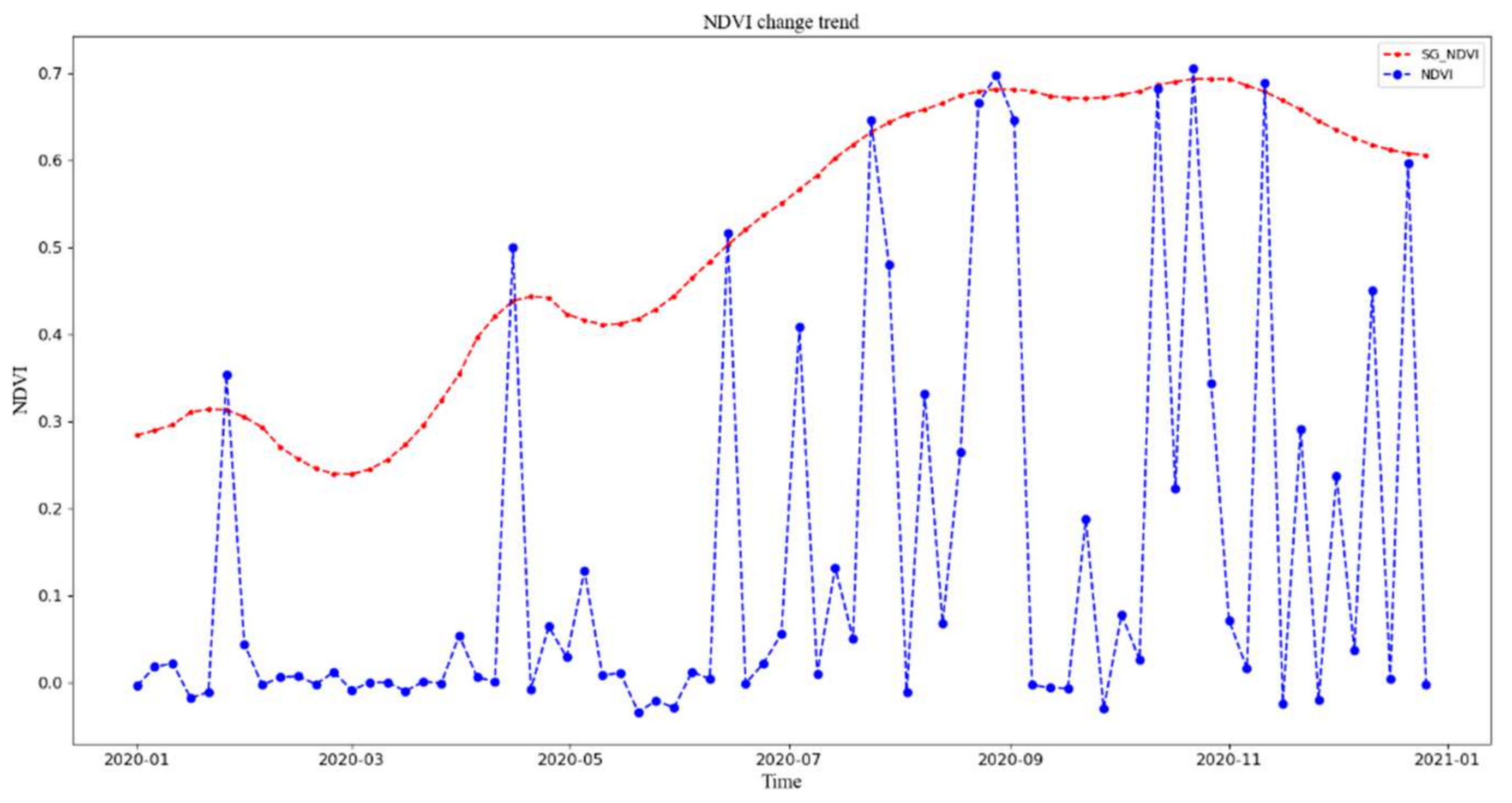
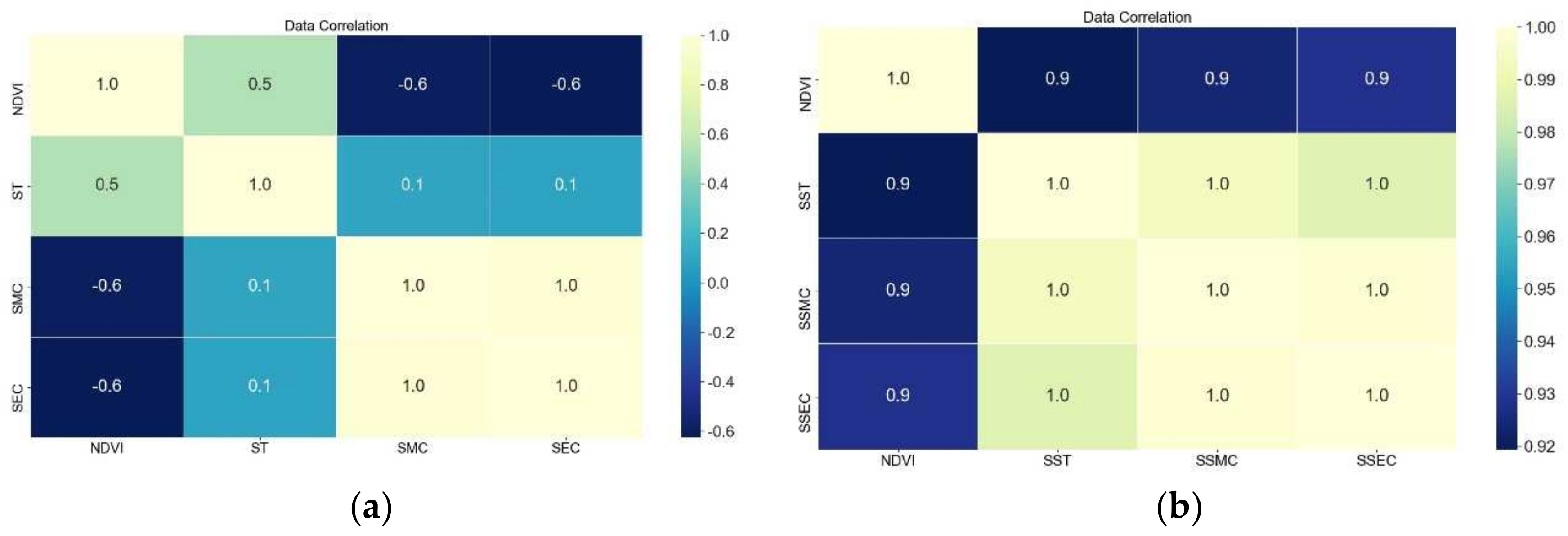
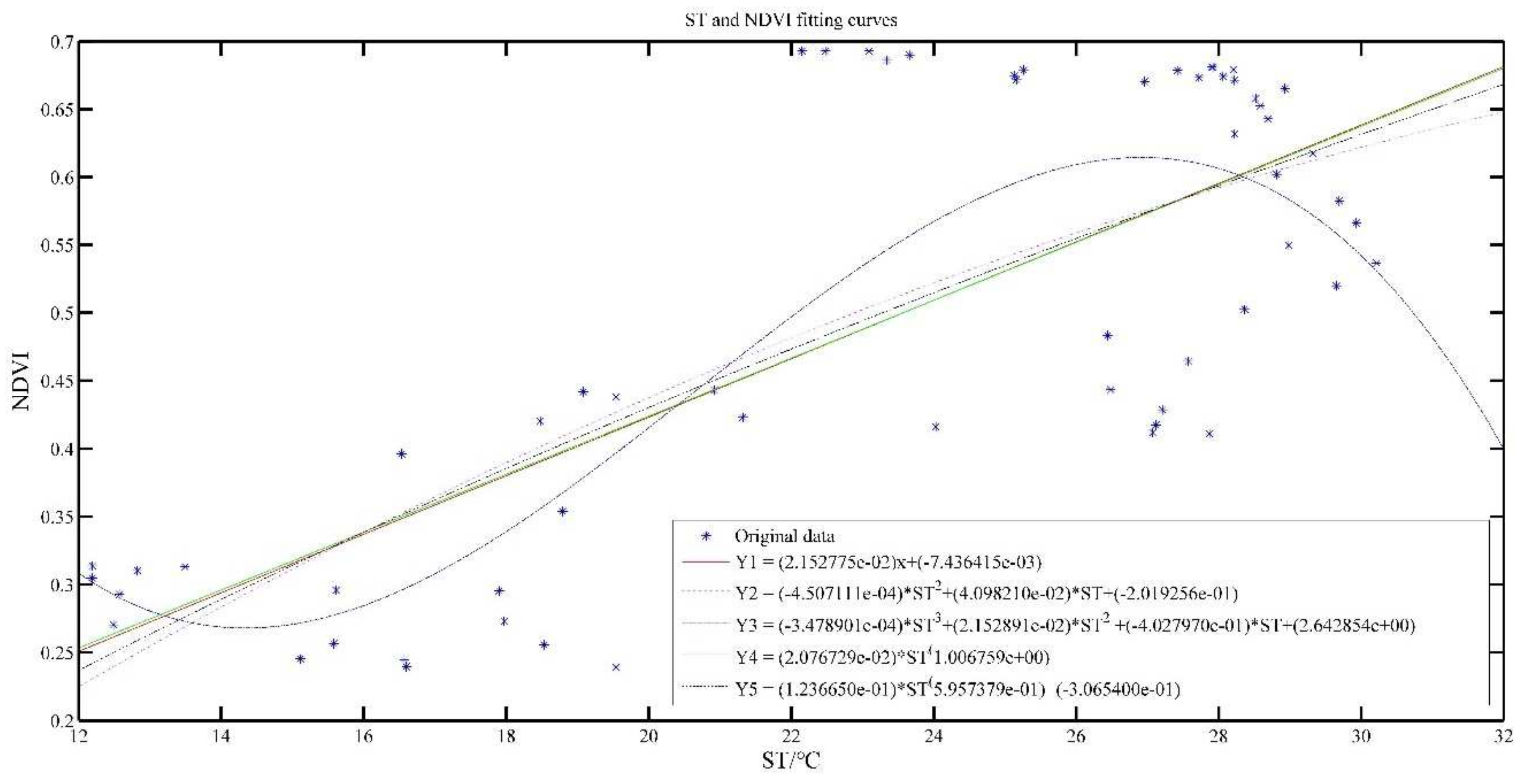
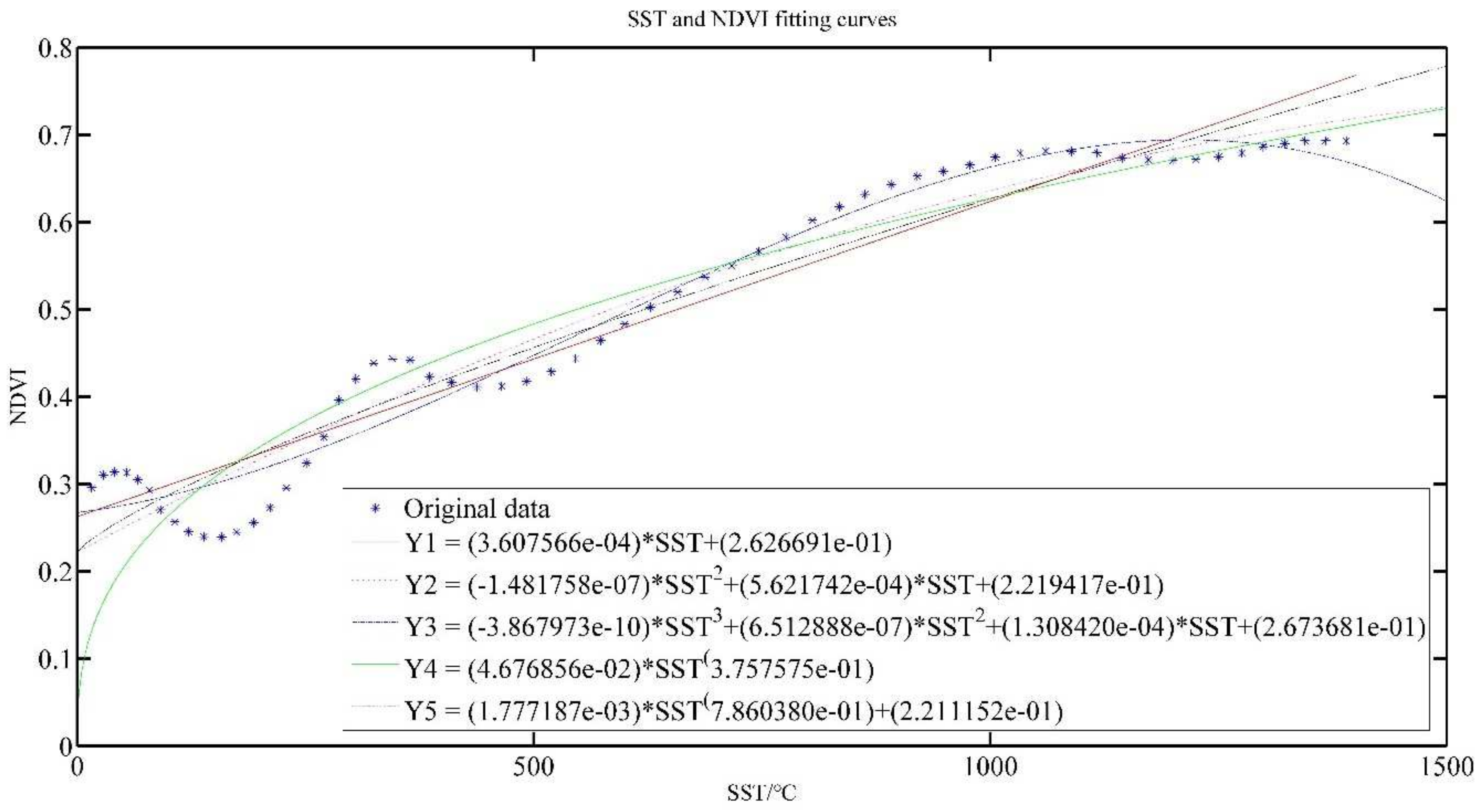
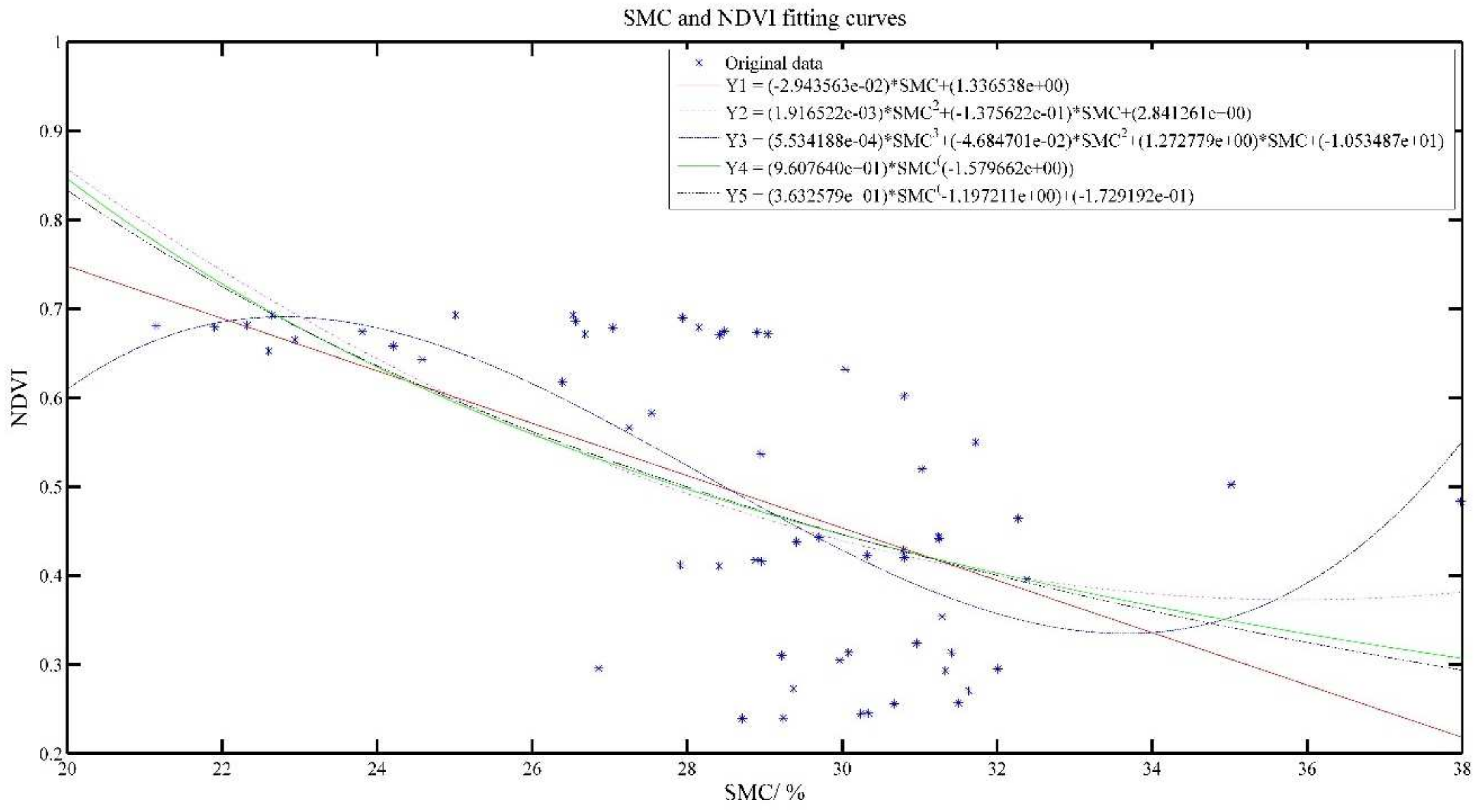
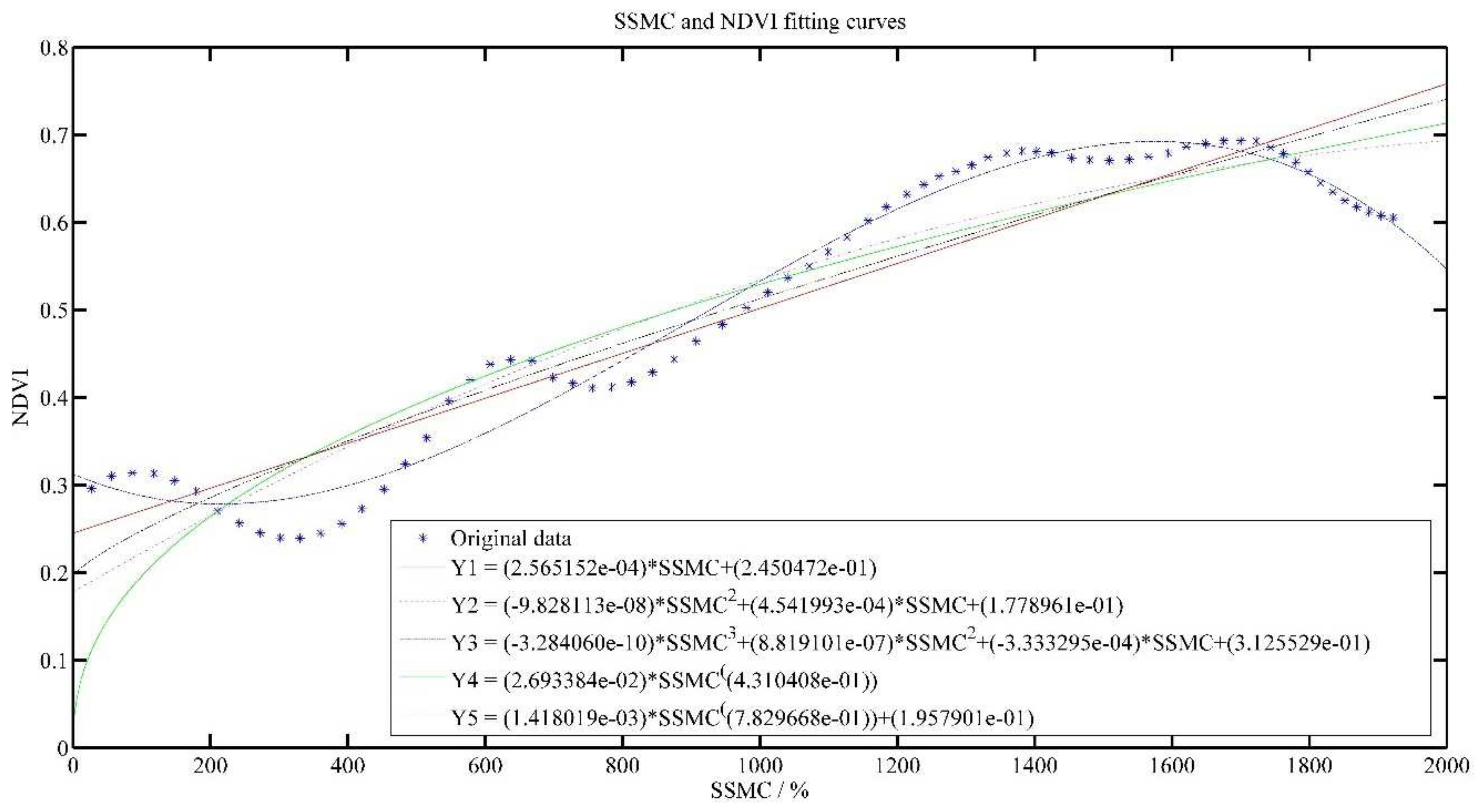
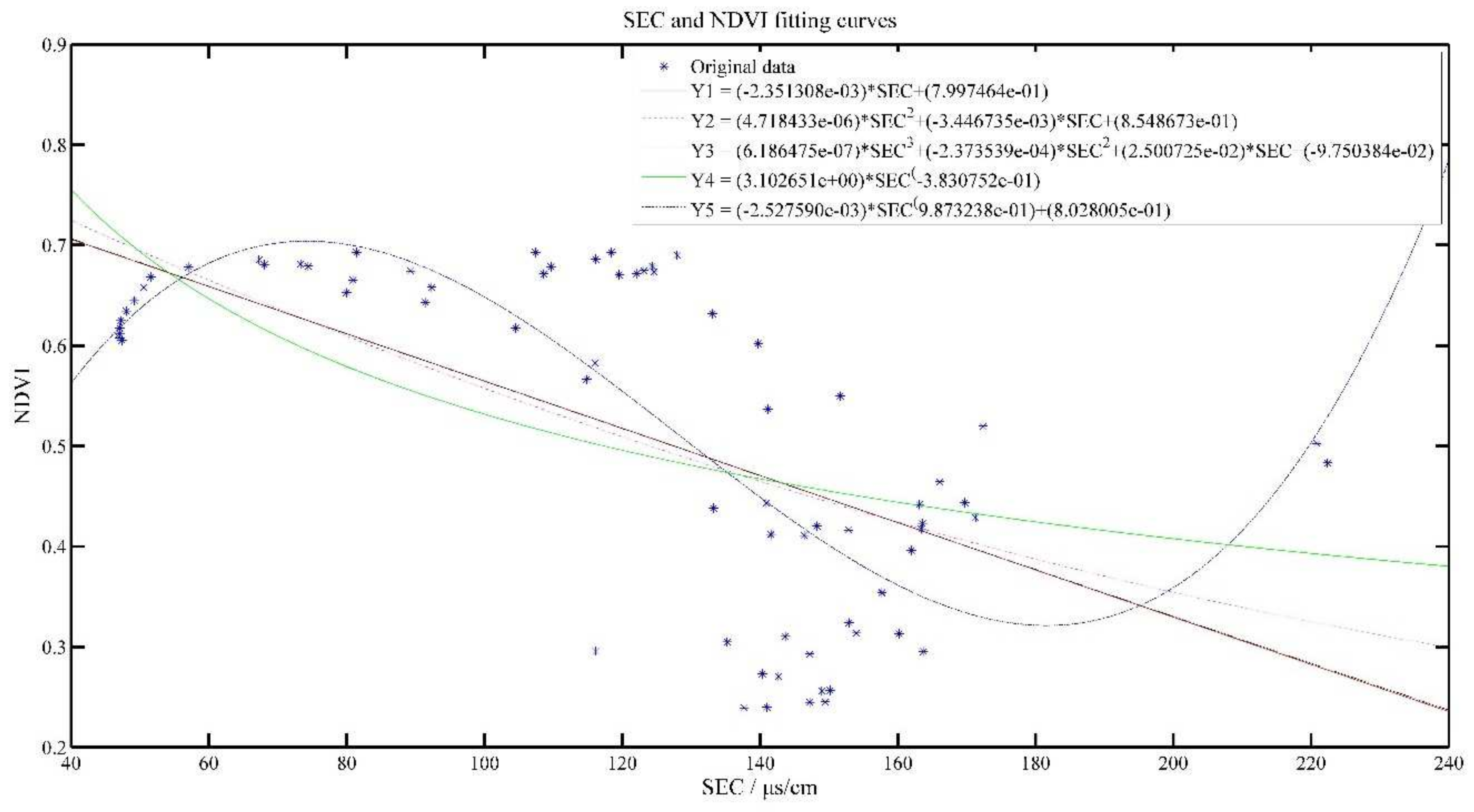
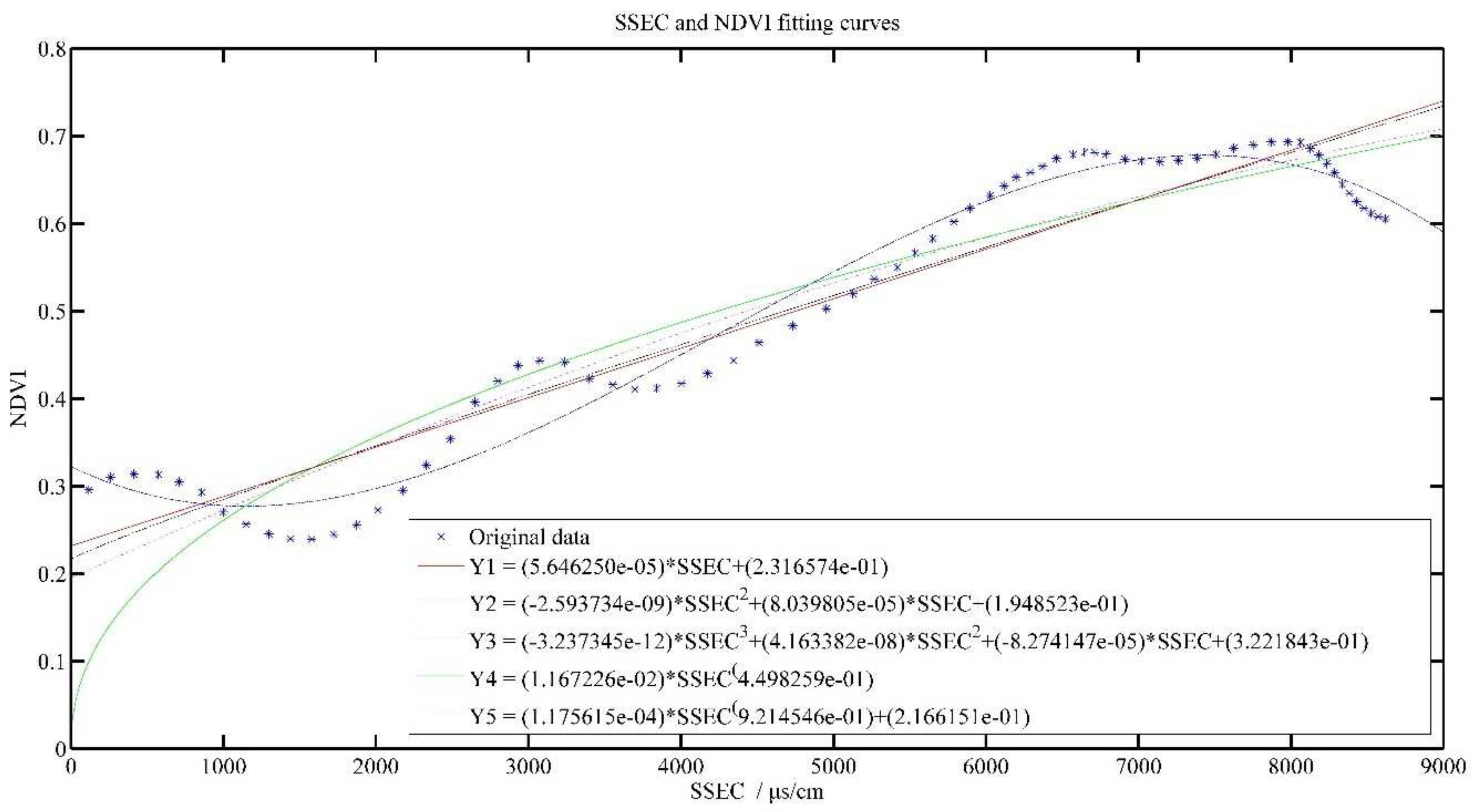
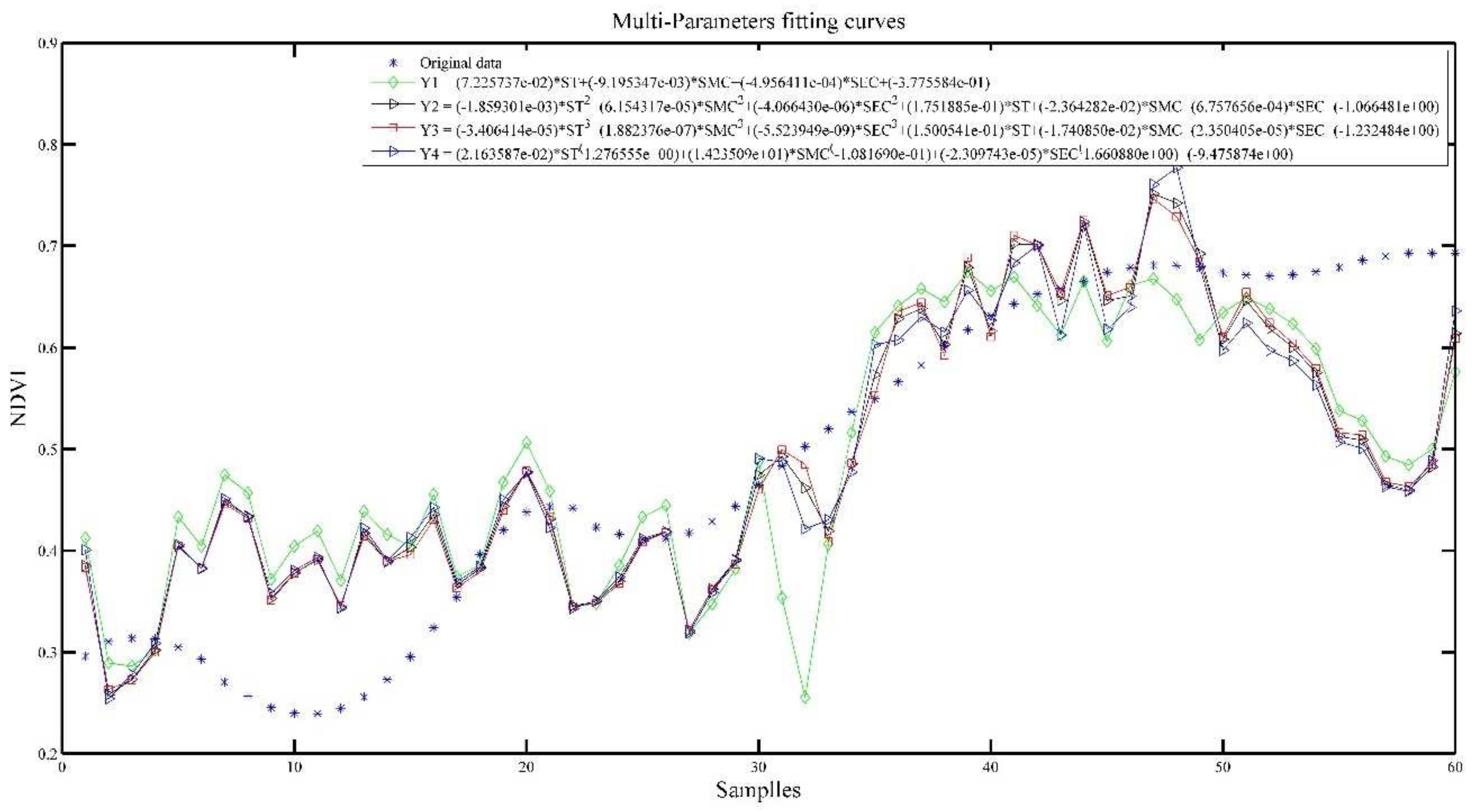
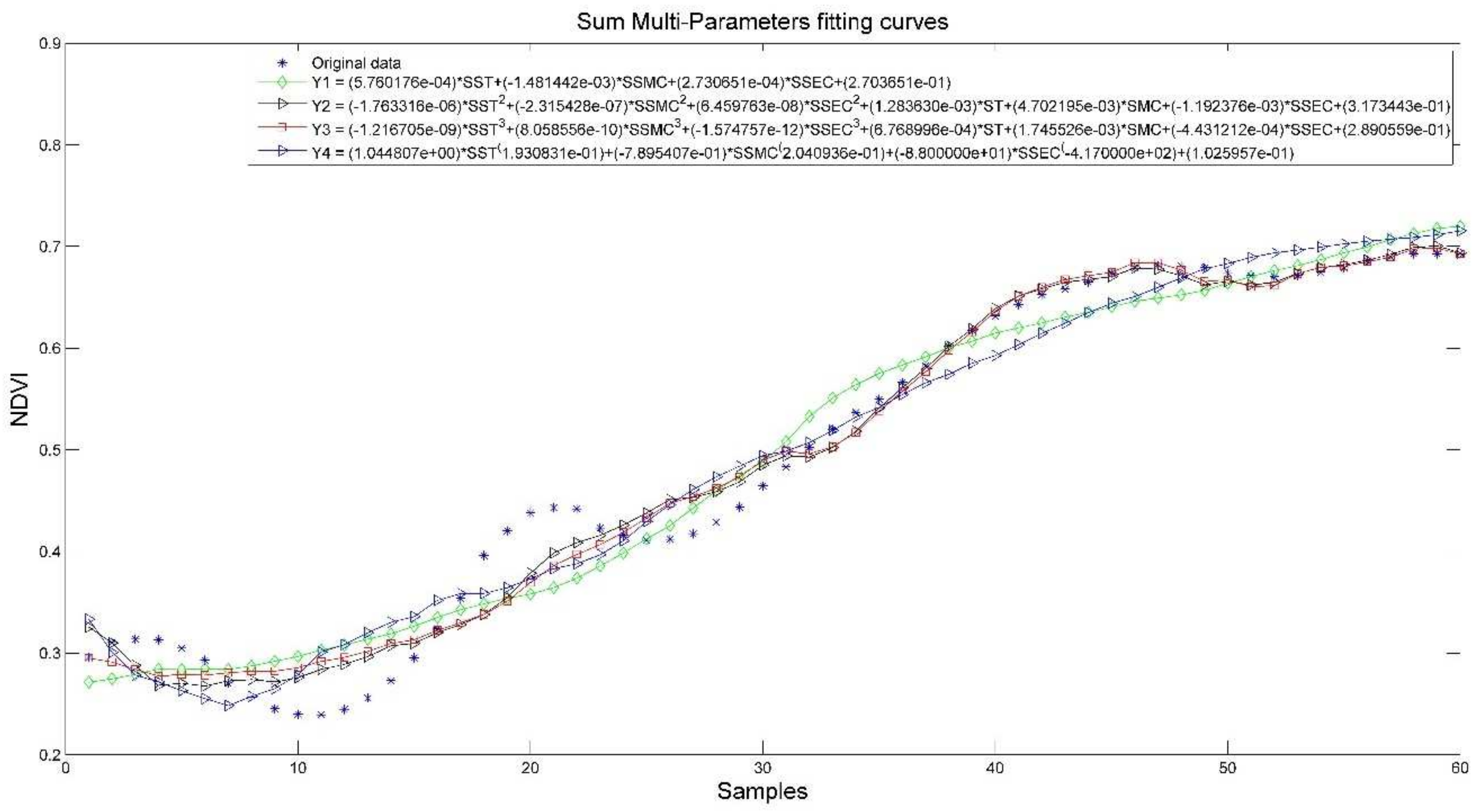
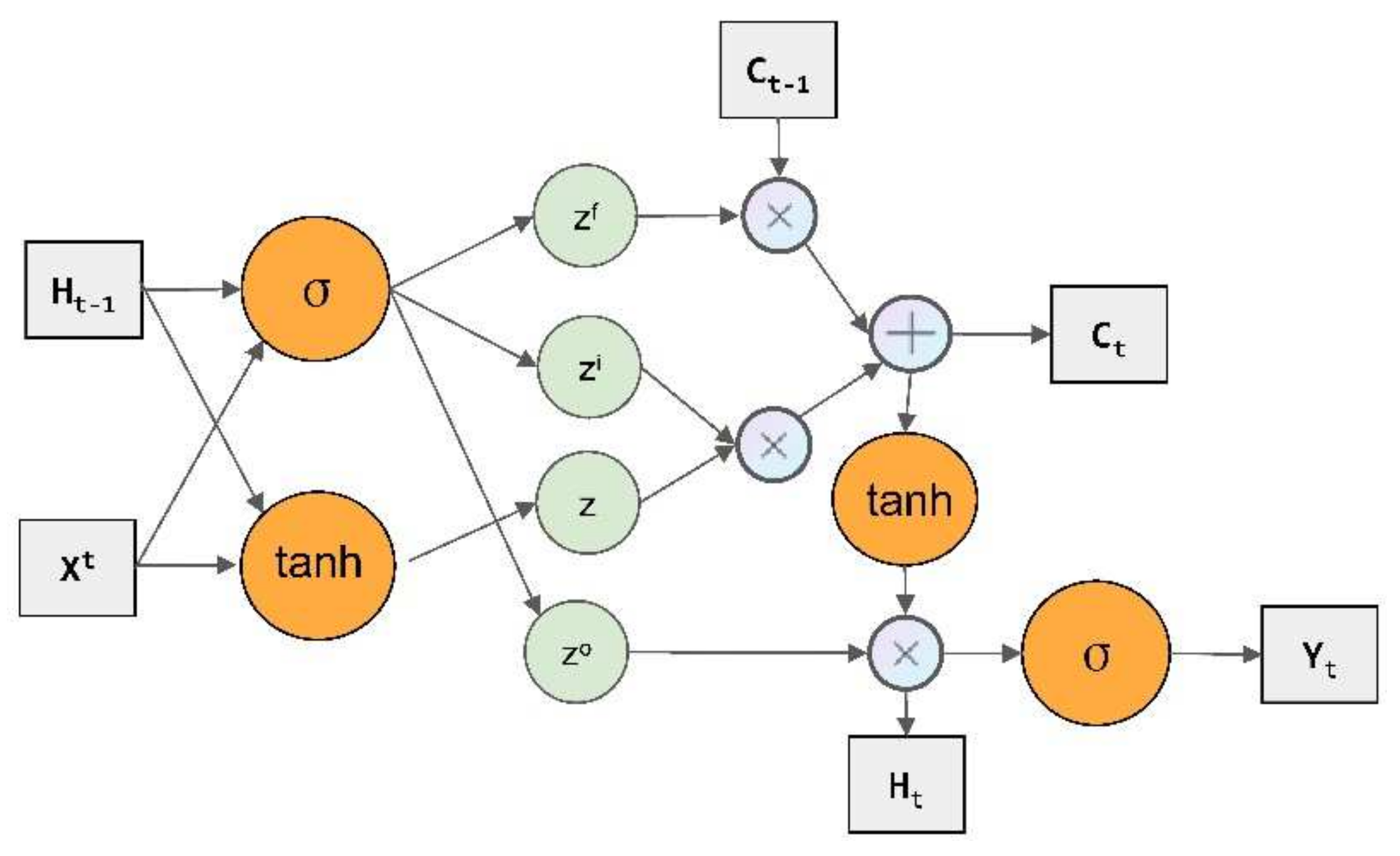
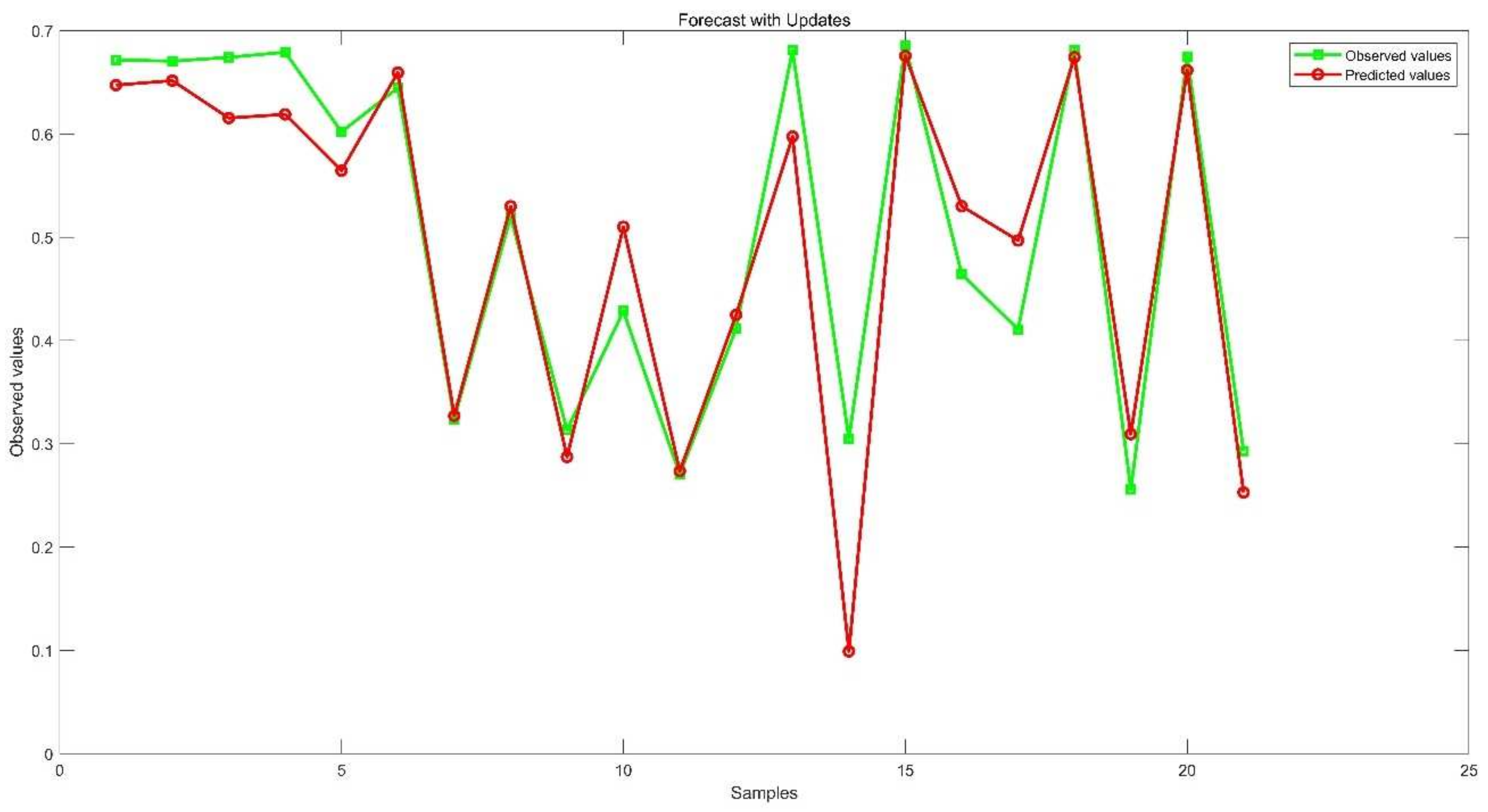
| Indicators | Range | Resolution | Precision |
|---|---|---|---|
| SMC | 0~50% 0~100% | 0.03% 1% | 2% (0~50%) 3% (50~100%) |
| SEC | 0–5000 μs/cm 10,000 μs/cm 20,000 μs/cm | 10 μs/cm 50 μs/cm 50 μs/cm | ±3% ±5% ±5% |
| ST | −40~80 °C | 0.1 °C | ±0.5 °C |
| No. | ST/°C | SMC/% | SEC/μs/cm | Time |
|---|---|---|---|---|
| 1 | 12.76 | 18.83 | 60 | 2020-12-31 23:51:31 |
| 2 | 12.85 | 18.87 | 60 | 2020-12-31 23:40:33 |
| 3 | 12.85 | 18.83 | 60 | 2020-12-31 23:30:30 |
| 4 | 12.85 | 18.83 | 60 | 2020-12-31 23:19:35 |
| 5 | 12.88 | 18.87 | 60 | 2020-12-31 23:08:32 |
| 6 | 12.88 | 18.83 | 60 | 2020-12-31 22:57:35 |
| 7 | 12.91 | 18.87 | 60 | 2020-12-31 22:47:32 |
| 8 | 12.97 | 18.87 | 60 | 2020-12-31 22:36:35 |
| 9 | 12.97 | 18.87 | 60 | 2020-12-31 22:26:32 |
| 10 | 12.97 | 18.87 | 60 | 2020-12-31 22:15:35 |
| Item | Model | SSE | RMSE | AR | |
|---|---|---|---|---|---|
| ST | Y1 | 0.6730 | 0.1077 | 0.5673 | 0.5599 |
| Y2 | 0.6654 | 0.1080 | 0.5723 | 0.5573 | |
| Y3 | 0.5649 | 0.1004 | 0.6369 | 0.6173 | |
| Y4 | 0.6732 | 0.1077 | 0.5672 | 0.5598 | |
| Y5 | 0.6704 | 0.1085 | 0.5690 | 0.5539 | |
| SST | Y1 | 0.1111 | 0.0438 | 0.9286 | 0.9274 |
| Y2 | 0.0815 | 0.0378 | 0.9476 | 0.9458 | |
| Y3 | 0.0563 | 0.0317 | 0.9638 | 0.9619 | |
| Y4 | 0.1642 | 0.0532 | 0.8945 | 0.8926 | |
| Y5 | 0.1000 | 0.0419 | 0.9357 | 0.9334 |
| Item | Model | SSE | RMSE | AR | |
|---|---|---|---|---|---|
| SMC | Y1 | 1.0757 | 0.1249 | 0.3916 | 0.3828 |
| Y2 | 1.0684 | 0.1253 | 0.3958 | 0.3780 | |
| Y3 | 0.7455 | 0.1055 | 0.5784 | 0.5595 | |
| Y4 | 1.1734 | 0.1304 | 0.3364 | 0.3268 | |
| Y5 | 1.0757 | 0.1258 | 0.3916 | 0.3738 | |
| SSMC | Y1 | 0.1959 | 0.0533 | 0.8892 | 0.8876 |
| Y2 | 0.1803 | 0.0515 | 0.8980 | 0.8950 | |
| Y3 | 0.0601 | 0.0300 | 0.9660 | 0.9645 | |
| Y4 | 0.2711 | 0.0627 | 0.8467 | 0.8445 | |
| Y5 | 0.1946 | 0.0535 | 0.8900 | 0.8867 |
| Item | Model | SSE | RMSE | AR | |
|---|---|---|---|---|---|
| SEC | Y1 | 1.0757 | 0.1249 | 0.3916 | 0.3828 |
| Y2 | 1.0684 | 0.1253 | 0.3958 | 0.3780 | |
| Y3 | 0.7455 | 0.1055 | 0.5784 | 0.5595 | |
| Y4 | 1.1734 | 0.1304 | 0.3364 | 0.3268 | |
| Y5 | 1.0757 | 0.1258 | 0.3916 | 0.3738 | |
| SSEC | Y1 | 0.1959 | 0.0533 | 0.8892 | 0.8876 |
| Y2 | 0.1803 | 0.0515 | 0.8980 | 0.8950 | |
| Y3 | 0.0601 | 0.0300 | 0.9660 | 0.9645 | |
| Y4 | 0.2711 | 0.0627 | 0.8467 | 0.8445 | |
| Y5 | 0.1946 | 0.0535 | 0.8900 | 0.8867 |
| Item | Model | SSE | RMSE | AR | |
|---|---|---|---|---|---|
| IMP | Y1 | 0.6619 | 0.1050 | 0.5745 | 0.5672 |
| Y2 | 0.5401 | 0.0949 | 0.6528 | 0.6468 | |
| Y3 | 0.5281 | 0.0938 | 0.6605 | 0.6547 | |
| Y4 | 0.5750 | 0.0979 | 0.6305 | 0.6241 | |
| SIMP | Y1 | 0.0695 | 0.0340 | 0.9553 | 0.9545 |
| Y2 | 0.0372 | 0.0249 | 0.9761 | 0.9757 | |
| Y3 | 0.0435 | 0.0269 | 0.9720 | 0.9715 | |
| Y4 | 0.0676 | 0.0336 | 0.9565 | 0.9558 |
| Item | Model | MSE | RMSE | AR | |
|---|---|---|---|---|---|
| ST | Y1 | 0.0745 | 0.2730 | 0.8907 | 0.8785 |
| Y2 | 0.0741 | 0.2722 | 0.8918 | 0.8798 | |
| Y3 | 0.0837 | 0.2893 | 0.8281 | 0.8090 | |
| Y4 | 0.0738 | 0.2717 | 0.8906 | 0.8785 | |
| Y5 | 0.0742 | 0.2724 | 0.8912 | 0.8791 | |
| SST | Y1 | 0.0299 | 0.1728 | 0.9902 | 0.9891 |
| Y2 | 0.0097 | 0.0986 | 0.9906 | 0.9896 | |
| Y3 | 0.0005 | 0.0226 | 0.9739 | 0.9710 | |
| Y4 | 0.0098 | 0.0989 | 0.9907 | 0.9897 | |
| Y5 | 0.0217 | 0.1472 | 0.9904 | 0.9893 |
| Item | Model | MSE | RMSE | AR | |
|---|---|---|---|---|---|
| SMC | Y1 | 0.0295 | 0.1718 | 0.5410 | 0.4900 |
| Y2 | 0.1230 | 0.3507 | 0.5559 | 0.5066 | |
| Y3 | 0.0504 | 0.2244 | 0.6218 | 0.5798 | |
| Y4 | 0.1347 | 0.3671 | 0.5757 | 0.5286 | |
| Y5 | 0.1123 | 0.3351 | 0.5706 | 0.5229 | |
| SSMC | Y1 | 0.0075 | 0.0867 | 0.9749 | 0.9721 |
| Y2 | 0.0027 | 0.0522 | 0.9858 | 0.9842 | |
| Y3 | 0.00006 | 0.0080 | 0.9341 | 0.9268 | |
| Y4 | 0.0036 | 0.0599 | 0.9768 | 0.9743 | |
| Y5 | 0.0058 | 0.0764 | 0.9757 | 0.9729 |
| Item | Model | SSE | RMSE | AR | |
|---|---|---|---|---|---|
| SEC | Y1 | 0.0033 | 0.0571 | 0.6807 | 0.6452 |
| Y2 | 0.0046 | 0.0680 | 0.6879 | 0.6532 | |
| Y3 | 0.0002 | 0.0126 | 0.8059 | 0.7843 | |
| Y4 | 0.0055 | 0.0739 | 0.7352 | 0.7058 | |
| Y5 | 0.0033 | 0.0575 | 0.6812 | 0.6458 | |
| SSEC | Y1 | 0.0056 | 0.0747 | 0.9778 | 0.9753 |
| Y2 | 0.0033 | 0.0575 | 0.9798 | 0.9776 | |
| Y3 | 0.0003 | 0.0192 | 0.9532 | 0.9479 | |
| Y4 | 0.0027 | 0.0517 | 0.9788 | 0.9764 | |
| Y5 | 0.0051 | 0.0713 | 0.9779 | 0.9755 |
| Item | Model | MSE | RMSE | AR | |
|---|---|---|---|---|---|
| IMP | Y1 | 0.0266 | 0.1630 | 0.8179 | 0.8148 |
| Y2 | 0.0078 | 0.0885 | 0.7149 | 0.7100 | |
| Y3 | 0.0237 | 0.1540 | 0.8051 | 0.8017 | |
| Y4 | 0.0298 | 0.1727 | 0.3282 | 0.3166 | |
| SIMP | Y1 | 0.0053 | 0.0727 | 0.8017 | 0.7983 |
| Y2 | 0.0002 | 0.0168 | 0.6594 | 0.6535 | |
| Y3 | 0.0057 | 0.0752 | 0.2617 | 0.2492 | |
| Y4 | 0.0103 | 0.1013 | 0.9308 | 0.9296 |
| Model | RMSE | MSE | MAE | MAPE | |
|---|---|---|---|---|---|
| LSTM | 0.5299 | 0.1642 | 0.0270 | 0.1518 | 36.8900 |
| BES-LSTM | 0.8666 | 0.0629 | 0.0040 | 0.0436 | 10.5257 |
Publisher’s Note: MDPI stays neutral with regard to jurisdictional claims in published maps and institutional affiliations. |
© 2022 by the authors. Licensee MDPI, Basel, Switzerland. This article is an open access article distributed under the terms and conditions of the Creative Commons Attribution (CC BY) license (https://creativecommons.org/licenses/by/4.0/).
Share and Cite
Huang, Y.; Jiang, H.; Wang, W. Research on Tea Tree Growth Monitoring Model Using Soil Information. Plants 2022, 11, 262. https://doi.org/10.3390/plants11030262
Huang Y, Jiang H, Wang W. Research on Tea Tree Growth Monitoring Model Using Soil Information. Plants. 2022; 11(3):262. https://doi.org/10.3390/plants11030262
Chicago/Turabian StyleHuang, Ying, Hao Jiang, and Weixing Wang. 2022. "Research on Tea Tree Growth Monitoring Model Using Soil Information" Plants 11, no. 3: 262. https://doi.org/10.3390/plants11030262
APA StyleHuang, Y., Jiang, H., & Wang, W. (2022). Research on Tea Tree Growth Monitoring Model Using Soil Information. Plants, 11(3), 262. https://doi.org/10.3390/plants11030262






